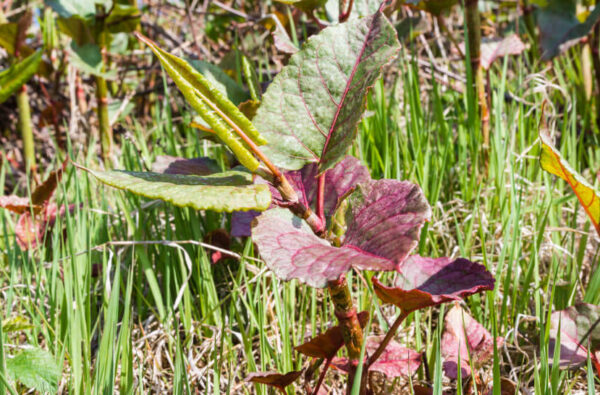Your guide to Japanese knotweed

Japanese knotweed may look attractive, but this invasive plant spells trouble for UK homeowners. Introduced as an ornamental plant from Asia in the 1800s, Japanese knotweed has since spread relentlessly across Britain. Its bamboo-like stems and shovel-shaped leaves emerge in spring to form dense thickets. Below ground, its network of creeping rhizome roots extends widely in all directions. This vigorous plant poses major headaches for homeowners in many ways:
- It can push through cracks and openings, damaging walls, foundations, pavements and other structures. Repairing this damage is extremely costly.
- The deep rhizome system makes DIY removal nearly impossible. Professional eradication requires ongoing herbicide treatment over several years costing thousands of pounds.
- Severe infestations can prevent mortgage lenders from approving loans due to impacts on property values, and saleability may also be affected.
- Homeowners who allow knotweed to spread can face legal action, fines and be liable for removal expenses. There are legal duties for control.
Whether you are a homebuyer or homeowner, learning to identify knotweed early and understand effective treatment options can prevent costly damage further down the line. If you want to purchase a property, rest assured that our detailed Building Surveys will report on any defects we find, including an assessment of the presence and severity of Japanese knotweed infestations and advice on appropriate actions for treatment and control.
What does Japanese knotweed look like?
Knotweed has distinctive triangular, shovel-shaped leaves up to 12 cm long by 7-10 cm wide. The leaves grow in a zig-zag fashion along the stalk at regular intervals. Mature plants can reach up to 3 metres in height. Japanese knotweed has dense clusters of small white flowers in summer and early autumn. The bamboo-like hollow stems are green with purple speckles and form dense thickets. The plant dies back in winter to orange-brown shoots.
How does it spread?
This invasive garden pest spreads rapidly and aggressively because of its strong underground rhizome root system. Each small rhizome fragment can regrow into a new plant. It can also spread by seeds but rhizome distribution is a major concern. Knotweed rhizomes can extend to just over 6 metres laterally and 3 metres deep. Any earth movement, digging, or stem fragment dispersal encourages Japanese knotweed’s advance. One plant can quickly become a colony covering a large area in just a few seasons.
Why is it so dangerous?
The vigorous root system enables knotweed to push through cracks in concrete, pavements, walls and foundations, causing serious structural damage. It poses a particular threat to historical sites and archaeological remains. Severe infestations can make properties challenging to sell and reduce values by up to 10%. The dense canes crowd out native plants and trees, altering local ecosystems and reducing biodiversity.
What does the law say?
The following legislation may affect homeowners with Japanese knotweed on their property. Here is a brief summary of what each entails:
- Environmental Protection Act 1990: Do not allow Japanese knotweed to spread into the wild or cause environmental damage. Follow proper disposal measures to prevent further growth.
- Wildlife and Countryside Act 1981: Avoid introducing or planting Japanese knotweed in the wild to protect native flora and fauna.
- Anti-Social Behaviour, Crime, and Policing Act 2014: If issued a Community Protection Notice (CPN) by local authorities or the police, comply with the notice and take necessary steps to control the spread of Japanese knotweed.
- The Property Misdescriptions Act 1991: As a seller, disclose any material information regarding Japanese knotweed infestations to potential buyers, as failure to do so can have legal consequences.
- Hazardous Waste Regulations 2005: Japanese knotweed is considered controlled waste under these regulations. Adhere to the regulations when handling, transporting, and disposing of Japanese knotweed to prevent environmental contamination.
- Waste Management Licensing Regulations 1994: If you’re involved in the commercial removal and disposal of Japanese knotweed, you may need to comply with these regulations. Ensure that you have the appropriate waste management licenses and follow the necessary procedures for handling and disposing of the knotweed.
How can you remove Japanese knotweed?
Trying to dig out or remove Japanese knotweed manually is extremely difficult due to the wide-spreading rhizomes which can extend several metres in all directions underground. Any remnants left behind regrow vigorously. Removing knotweed yourself also risks further spread. Professional herbicide treatment over several growing seasons is required to fully eradicate an infestation. Waste must be disposed of at licensed landfills.
Attempting do-it-yourself removal is not advised. The most effective approach is contracting accredited Japanese knotweed specialists. They can create an eradication plan which likely includes cutting the stems and on-site injection of powerful herbicides into the root system. This may need to be repeated over several seasons. You’ll receive a treatment certificate to show lenders and buyers the infestation is under management. Expect to pay from £2,500-£5,000 for initial professional knotweed treatment depending on severity.
In conclusion, Japanese knotweed requires extensive long-term treatment plans to fully eradicate and prevent regrowth. Crucially, most mortgage lenders will not approve loans on affected properties without evidence that a professional knotweed management programme is in place. They will typically require a recent certificate along with a minimum 5-year treatment plan from an accredited contractor.
For home buyers, if a property has Japanese knotweed present, ensure documented treatment plans exist and read all paperwork thoroughly. Get a confirmation that ongoing management will be transferred to you as the new owner. Seek a treatment guarantee and factor the costs into negotiations. With professional help, Japanese knotweed can be controlled, but failing to continue treatment can lead to a costly and disruptive resurgence. Stay vigilant in monitoring and proactively addressing this invasive species.
Alan Rance Surveyors have more than 40 years experience of in surveying residential properties and historic buildings, providing high-quality building surveys and home buyers surveys in Buckinghamshire, Bedfordshire and Hertfordshire, and delivering exceptional service and excellent value for money. For professional advice and a competitive quote, please contact us.

